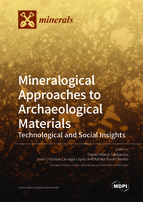Mineralogical Approaches to Archaeological Materials: Technological and Social Insights
A special issue of Minerals (ISSN 2075-163X). This special issue belongs to the section "Crystallography and Physical Chemistry of Minerals & Nanominerals".
Deadline for manuscript submissions: closed (30 April 2022) | Viewed by 31633
Special Issue Editors
Interests: archaeometry; archaeological ceramics; ceramic petrography; social technology; raw materials
Interests: archaeometry; ceramic materials; petrography; Islamic archaeology
Interests: cultural heritage; materials science
Special Issues, Collections and Topics in MDPI journals
Special Issue Information
Dear Colleagues,
In this Special Issue of Minerals, we would like to gather a bunch of papers centered on showing the potential of mineralogical studies (e.g., petrography, mineral geochemistry, X-ray diffraction) to approach the composition of a wide diversity of archaeological materials such as ceramics, metals, stone artifacts, and sediments. The main objective is to demonstrate that the mineralogical characterization of these artifacts is crucial to address aspects related to the origin of the raw materials used in their manufacture and the technological processes applied by craftspeople.
We are interested in emphasizing the necessary relationship that must exist between natural sciences and social sciences when addressing the material culture related to human societies. In this sense, this issue is wide open to all those researchers who want to delve into the role of mineralogical analyses in the characterization of materiality and its potential to address anthropological concerns. Therefore, very welcomed will be works that develop methodological approaches, compositional analysis of the artifacts, study of the physical properties provided by minerals, and, of course, studies focused on interpreting the social and symbolic role that minerals play in both ancient and contemporary human societies.
Dr. Daniel Santacreu
Dr. José Cristóbal Carvajal López
Prof. Dr. Adrián Durán Benito
Guest Editors
Manuscript Submission Information
Manuscripts should be submitted online at www.mdpi.com by registering and logging in to this website. Once you are registered, click here to go to the submission form. Manuscripts can be submitted until the deadline. All submissions that pass pre-check are peer-reviewed. Accepted papers will be published continuously in the journal (as soon as accepted) and will be listed together on the special issue website. Research articles, review articles as well as short communications are invited. For planned papers, a title and short abstract (about 100 words) can be sent to the Editorial Office for announcement on this website.
Submitted manuscripts should not have been published previously, nor be under consideration for publication elsewhere (except conference proceedings papers). All manuscripts are thoroughly refereed through a single-blind peer-review process. A guide for authors and other relevant information for submission of manuscripts is available on the Instructions for Authors page. Minerals is an international peer-reviewed open access monthly journal published by MDPI.
Please visit the Instructions for Authors page before submitting a manuscript. The Article Processing Charge (APC) for publication in this open access journal is 2400 CHF (Swiss Francs). Submitted papers should be well formatted and use good English. Authors may use MDPI's English editing service prior to publication or during author revisions.
Keywords
- archaeometry
- ceramics
- glazes
- metals
- sediments
- stone
- mineralogy
- petrography
- geochemistry








